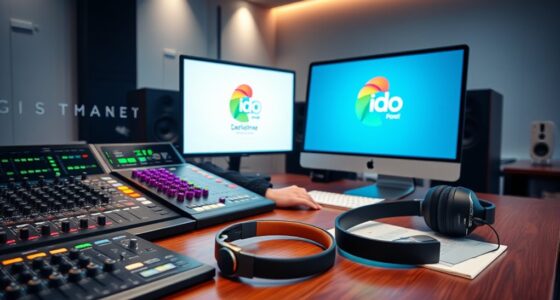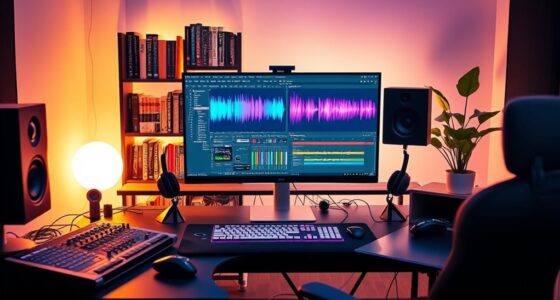Landing your first film or TV sync placement starts with understanding licensing rights and preparing high-quality, well-organized music with clear metadata. Build a diverse catalog of songs suited for various media and create professional demos tailored to industry needs. Connect with music supervisors and industry professionals through networking and targeted outreach. Craft concise, personalized pitches and understand licensing terms thoroughly. Keep building relationships and refining your approach—continue exploring these steps to open your first placement success.
Key Takeaways
- Prepare high-quality, well-organized music with detailed metadata to increase credibility and licensing chances.
- Build a diverse catalog showcasing various genres and tailor pitches to specific media projects.
- Research and connect with music supervisors through targeted, personalized outreach efforts.
- Craft concise, relevant pitches that highlight how your music fits the project’s scene or mood.
- Understand licensing terms, rights, and fees thoroughly to negotiate fair agreements and protect your rights.
Understanding Sync Licensing and Its Importance

Understanding sync licensing is vital because it grants you the legal right to use music in visual media such as films, TV shows, commercials, and online videos. This process involves music synchronization, where you align music with visual content to create a compelling experience. Securing proper licensing is key to avoid legal issues and ensure your project’s success. During licensing negotiations, you’ll discuss terms like usage scope, duration, and payment, which directly impact your budget and rights. Knowing how to navigate these negotiations helps you obtain the necessary permissions efficiently. Without understanding sync licensing, you risk infringing on rights or facing costly legal challenges. Mastering this knowledge empowers you to confidently incorporate music into your media projects while respecting artists’ rights. Additionally, understanding the role of high-quality audio and clear sound is crucial, as it enhances the overall viewer experience and aligns with the importance of proper audio calibration.
Preparing Your Music for Film and TV Placements
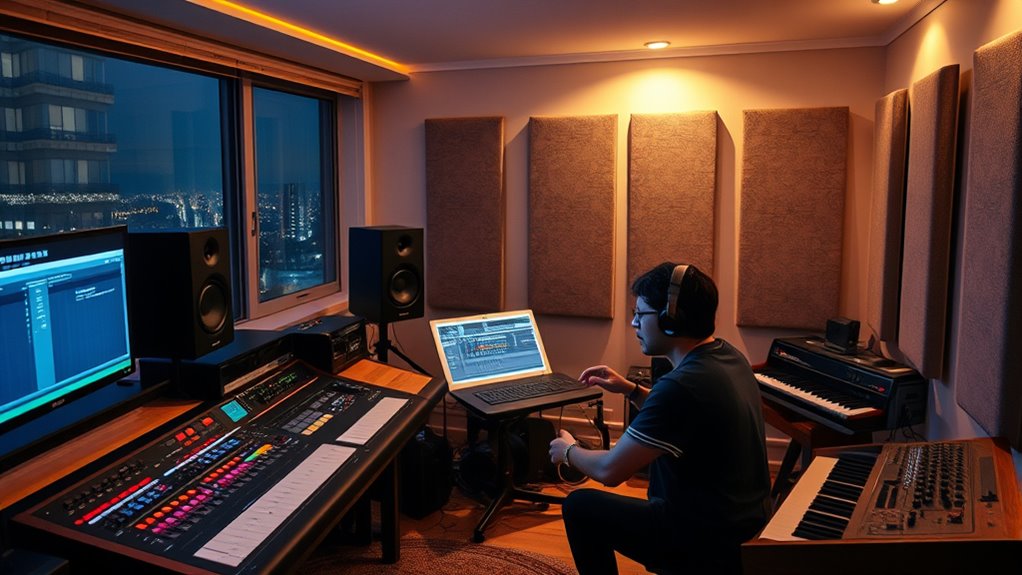
Once you grasp the importance of securing proper sync licenses, the next step is ensuring your music is ready for film and TV placements. Prepare high-quality recordings that reflect your best work, as producers and music supervisors will evaluate your tracks quickly. Organize your music with clear, detailed metadata—titles, artist info, and licensing details—to streamline music licensing and sync negotiations. Consider creating multiple versions of your tracks, such as instrumental or shorter edits, to increase your chances of placement. Make sure your music is professionally mixed and mastered to sound polished on screen. Being prepared with well-organized, high-quality music helps facilitate smooth negotiations and demonstrates your professionalism, making it easier for industry professionals to select and license your work. Recognizing the significance of angel number soulmate patterns can also inspire confidence and positivity during the licensing process.
Creating a Professional Demo and Metadata
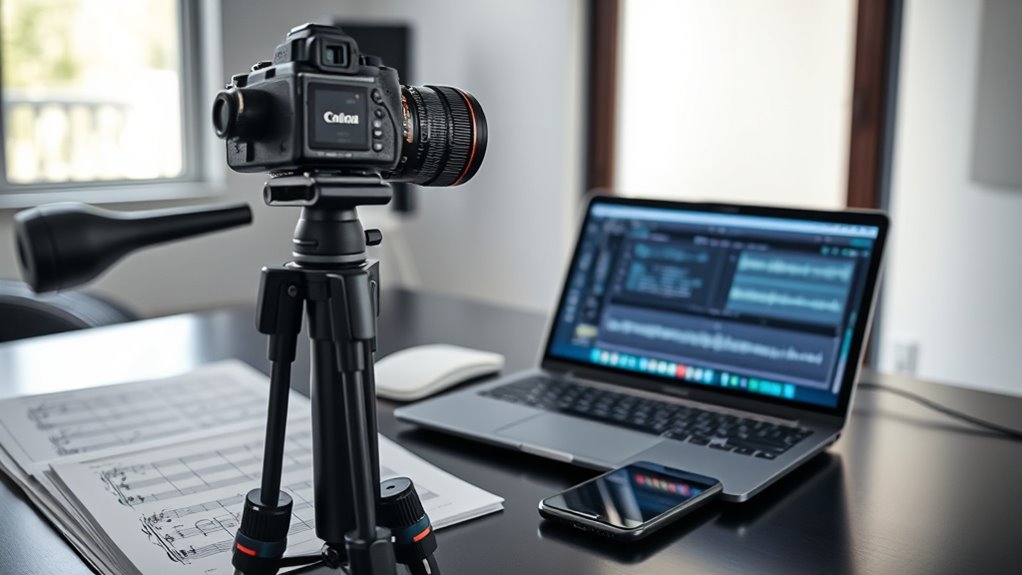
Creating a professional demo and accurate metadata is essential to making a strong impression on music supervisors and producers. Your demo should showcase your music’s versatility across different music genres, highlighting your unique sound while remaining polished. Keep recordings high quality and avoid overproduction that might distort your true style. When it comes to metadata, be precise with song titles, artist information, and licensing fees. Clear metadata helps supervisors quickly identify whether your track fits their project and if it’s financially viable. Including details like genre, mood, and potential licensing fees ensures transparency and streamlines the licensing process. Ultimately, a well-crafted demo paired with detailed metadata boosts your credibility and increases your chances of landing those coveted film and TV placements. Additionally, understanding Vetted – How Get Divorce can help artists navigate personal transitions that may influence their creative work and licensing opportunities.
Identifying and Connecting With Music Supervisors

To connect with music supervisors, you need to identify the right contacts by doing thorough research. Craft personalized messages that show you understand their needs and stand out from the crowd. Building genuine relationships takes time, so focus on consistent, professional communication to stay top of mind. Utilizing effective communication techniques like building rapport can significantly improve your chances of establishing successful collaborations.
Research Key Contacts
How do you find the right music supervisor for your project? Start by researching within the music industry, focusing on supervisors who work on your genre or style. Use industry directories, LinkedIn, and professional networks to compile a list of potential contacts. Pay attention to their credits and recent work to ensure alignment with your project’s vibe. When identifying key contacts, consider legal considerations, such as their authorization to license music and their familiarity with licensing processes. It’s essential to verify their role and reputation to avoid legal pitfalls later. Gathering this information helps you target the right people efficiently, increasing your chances of making a meaningful connection that can lead to a successful sync placement. Additionally, understanding juice detox can inform your approach to maintaining energy and focus during your outreach efforts.
Craft Personalized Outreach
Once you’ve identified the right music supervisors for your project, crafting personalized outreach can make all the difference. Instead of generic messages, tailor your pitch to reflect their specific needs and preferences. Highlight your music branding to demonstrate how your songs fit their style. Avoid sync licensing myths that suggest quick success; instead, show professionalism and genuine interest. Mention specific projects they’ve worked on to establish a connection. Keep your message concise, respectful, and engaging—show that you’ve done your homework. By personalizing your outreach, you increase the chances of standing out and building trust. Remember, music supervisors appreciate artists who understand their vision and are willing to collaborate, so make every interaction count. Understanding the importance of music licensing strategies can further refine your approach and improve your chances of success.
Build Genuine Relationships
Building genuine relationships with music supervisors requires more than just sending pitches; it’s about establishing trust and rapport over time. Focus on effective industry networking by attending industry events, workshops, and conferences to meet supervisors face-to-face. Consistently demonstrate your artist branding by sharing your music authentically and professionally, so they remember your sound and style. Take the time to research their projects and preferences, then tailor your interactions accordingly. Don’t just push your music—build a connection through meaningful conversations and follow-ups. As your relationship deepens, supervisors will see you as a reliable, relatable artist. Over time, this authenticity and consistency can lead to valuable sync opportunities in film and TV, making your music a natural fit for their projects. Developing a strong portfolio of diverse, high-quality tracks can significantly improve your chances of landing placements and building lasting industry relationships.
Building Your Catalog and Pitching Effectively
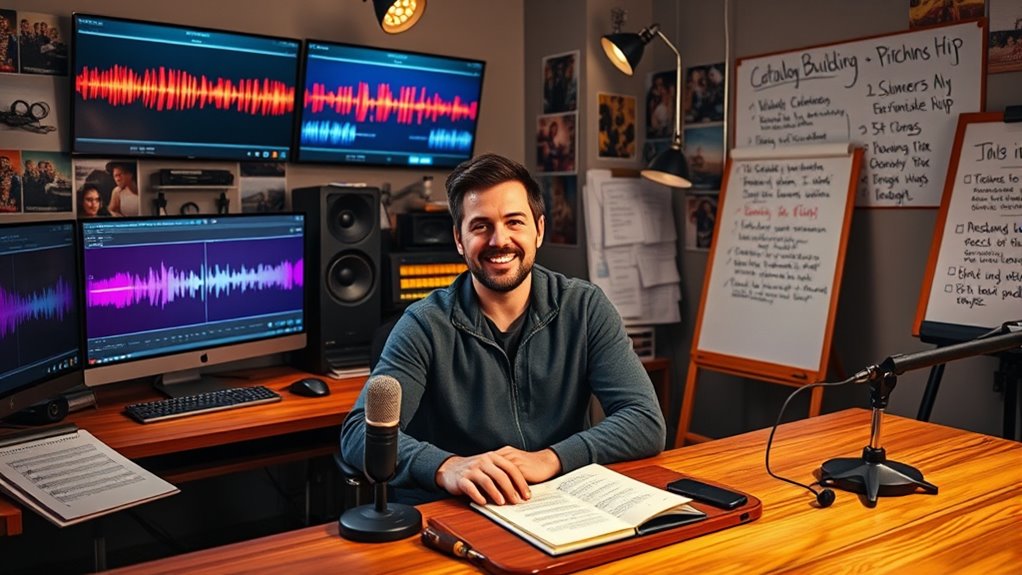
To attract sync opportunities, you need a diverse catalog that showcases your versatility. Focus on crafting a targeted pitch that highlights how your music fits specific projects. This approach helps you stand out and makes it easier for music supervisors to see your value. Incorporating insights from personality assessments can also enhance your understanding of your strengths, enabling you to tailor your presentations more effectively personality traits.
Curate a Diverse Portfolio
Creating a diverse portfolio is essential for standing out in sync licensing. By showcasing genre diversity, you demonstrate your ability to produce various styles that fit different projects. This broadens your appeal to music supervisors seeking fresh, versatile tracks. Licensing diversity also matters—include songs suited for TV dramas, commercials, and films to increase your chances of placement. A well-rounded catalog not only attracts more opportunities but also shows your adaptability as a creator. Keep your collection organized and regularly update it with new material across genres and formats. Incorporating familiarity with different media types can further demonstrate your versatility and readiness for various licensing needs. This approach signals your flexibility and readiness for a wide range of licensing opportunities. Ultimately, a curated, diverse portfolio positions you as a valuable and dependable source for sync placements.
Craft a Targeted Pitch
A well-curated, diverse portfolio sets the foundation for effective pitching. When you craft a targeted pitch, focus on demonstrating how your music aligns with specific sync opportunities. Research the project thoroughly—understand its tone, style, and audience—so you can tailor your pitch accordingly. Highlight the tracks that best fit the scene or mood, emphasizing their suitability for music licensing in that context. Keep your pitch concise and professional, clearly stating why your music is a perfect fit. Personalize your message, referencing the project or filmmaker directly. This targeted approach shows you understand their needs and increases your chances of landing sync placements in film and TV. Effective pitching transforms your catalog into compelling opportunities for music licensing success. Additionally, understanding the importance of maximizing space and organization in your catalog can streamline the selection process and make your pitches more compelling.
Navigating Licensing Agreements and Rights Management

Understanding licensing agreements and rights management is essential for ensuring your music is used legally and fairly. When negotiating, pay close attention to how royalty payments are structured and how licensing fees are calculated. These agreements specify how you’ll be compensated when your music is licensed, including upfront fees and ongoing royalties. Make sure you clearly understand the scope of rights you’re granting—whether it’s synchronization, master use, or both—and any restrictions on usage. Carefully review terms related to duration, territory, and exclusivity. Being thorough helps prevent misunderstandings and protects your rights. If needed, consider consulting a licensing expert or attorney to clarify complex clauses. Properly navigating these agreements ensures you’re fairly compensated and your rights are maintained throughout the licensing process.
Promoting Your Music and Networking Strategies
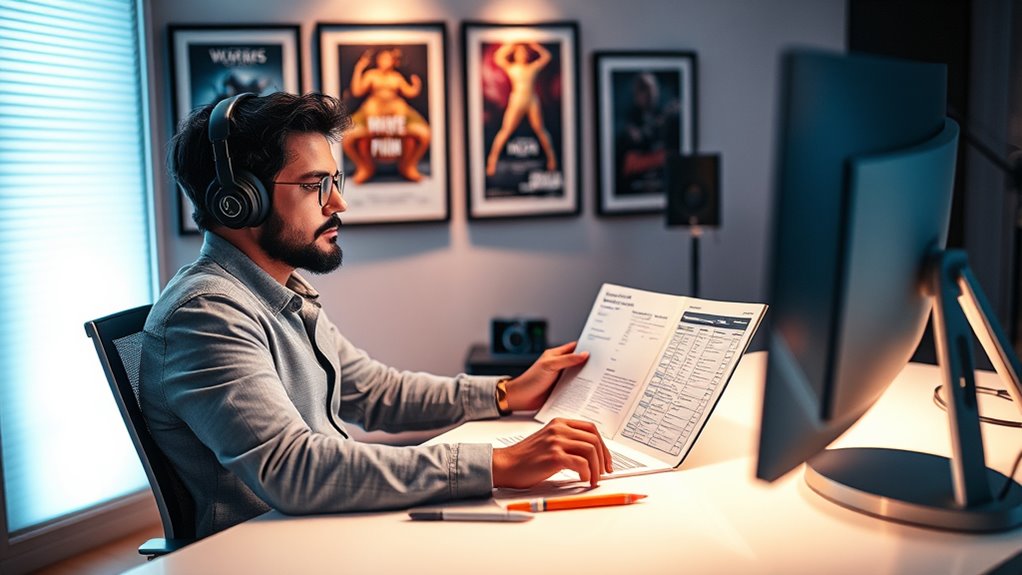
Once you’ve secured your licensing agreements, the next step is to guarantee your music reaches the right audience. Promote your work actively through social media platforms, sharing clips, updates, and success stories to build awareness. Engage with industry professionals, composers, and music supervisors by commenting, collaborating, and showcasing your portfolio online. Attend industry events, conferences, and networking meetups to make direct connections and learn about new opportunities. Your goal should be to position yourself as a serious, accessible artist who understands the sync licensing landscape. Consistency is key—regular posting and genuine interactions help establish your reputation and expand your network. Remember, building relationships and visibility are as vital as creating great music for landing future placements.
Common Challenges and How to Overcome Them

Finding your way through the world of sync licensing presents several common challenges that can trip up even experienced artists. One major hurdle is navigating music royalty issues, which can be confusing and sometimes lead to unpaid or underpaid royalties. Copyright confusion is another frequent problem, making it hard to determine who owns what and how to clear rights properly. To help visualize, consider this:
| Challenge | Solution |
|---|---|
| Music royalty issues | Work with a licensing expert and use clear contracts |
| Copyright confusion | Keep detailed records of ownership and rights transfers |
| Negotiation hurdles | Practice pitch skills and understand industry standards |
Addressing these challenges head-on ensures smoother licensing, so you can focus on creating great music.
Next Steps After Your First Placement

After landing your first sync placement, it’s crucial to review the deal thoroughly and confirm all terms are clear. Understanding your rights and royalty collection processes ensures you get paid correctly and on time. Next, focus on building relationships with music supervisors and licensing agents to secure future opportunities. Keep track of your licensing agreements and usage to streamline royalty collection. Stay proactive in promoting your catalog for more placements. You should also:
- Monitor your royalty payments regularly
- Register your music with PROs (Performing Rights Organizations)
- Keep detailed records of all licensing deals
- Continue networking within the industry
- Stay informed about changes in music licensing laws
These steps help solidify your presence in the sync licensing space and maximize your earnings from every placement.
Frequently Asked Questions
How Long Does It Typically Take to Land My First Sync Placement?
Timing expectations for landing your first sync placement vary, but it often takes several months to a year. Industry milestones like building relationships, submitting quality work, and understanding licensing processes influence this timeline. Be patient and persistent, as networking and refining your craft are key. While some artists land placements quickly, most experience a gradual process, so stay proactive and keep pushing forward to increase your chances of success.
What Are the Most Common Mistakes New Composers Make in Sync Licensing?
When starting in sync licensing, you often make mistakes like overlooking copyright issues or misunderstanding licensing terms. You might assume all licenses are the same or neglect to clarify rights ownership, risking legal trouble. To avoid this, always double-check copyright status and fully understand licensing agreements. This helps you safeguard your work and ensures smooth placements, preventing costly misunderstandings that can delay or jeopardize your opportunities in film and TV.
How Do I Protect My Music Rights During Negotiations?
Did you know that 70% of licensing disputes stem from unclear rights? During licensing negotiations, you need to protect your music rights by clearly defining ownership and usage terms. Always have a written agreement, specify the scope of licensing, and retain copyright control. Don’t rely solely on verbal promises—professional legal advice guarantees your rights are secure, preventing future disputes and safeguarding your creative work.
Are There Specific Genres or Styles More in Demand for Sync Placements?
You’ll find that genre trends and stylistic preferences heavily influence sync placements. Currently, comedy often favors upbeat pop or light indie tracks, while dramas lean toward emotional ballads or atmospheric sounds. Keep an eye on trending genres like electronic, alternative, or even niche styles, as they’re increasingly in demand. Staying adaptable and understanding current stylistic preferences helps you target the right projects and increases your chances of securing placements.
What Fees or Royalties Should I Expect From My First Placement?
Ever wonder what you’ll earn from your first sync placement? You can expect royalty rates to vary widely, often around 10-20% of the licensing fee, while licensing fees depend on the project’s scope and budget. Will your work be featured in a blockbuster or a short film? These factors influence your earnings, but understanding industry standards helps you set realistic expectations for royalties and licensing fees.
Conclusion
Landing your first sync placement is like planting a seed; with patience and persistence, it will grow into a thriving tree. Keep honing your craft, building relationships, and steering through the licensing landscape. Every step you take adds a new branch to your musical forest, strengthening your roots and expanding your reach. Stay dedicated, and soon your music will flourish in the cinematic landscape, reaching audiences in ways you once only dreamed of.



